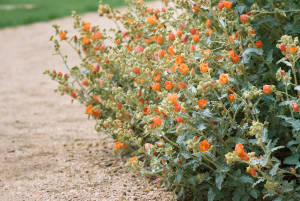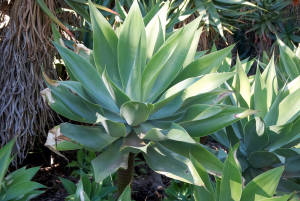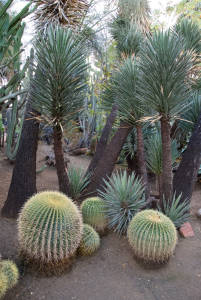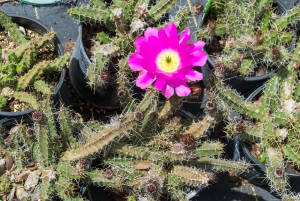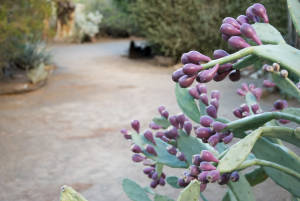
An Expert Reimagines The Drought Garden
In the rush to find solutions to California’s continuing water crisis a few considerations become evident: first, there are many differing opinions on how to best approach climate change, and few of these solutions will be easy to achieve if we don’t consider the ebb-and-flow of nature.
I can still remember the sound of hail falling from the sky during my first California El Niño– it mimics the sound my fingers make today as they click against my keyboard. I was in the first grade and my classmates– especially those that had never seen snow before– grabbed handfuls of the hail and scooped it into their lunchbox. How long can we preserve these tiny and miraculous molecules? We thought.
How many pieces can land on my tongue? I soon learned to ask the more important questions— What is El Niño? What steps have we taken to prepare for this season of storms?– but the answers to these questions are ones that continue to evade even the most sustainability-focused experts.
Plants do more than enchant the eyes and bellies of mammals and small insects– they also act as a blockade to stop mud and homes from skating on by.
While El Niño’s definition may be fixed (The National Oceanic and Atmospheric Administration defines El Niño as a “larger-scale ocean-atmosphere climate interaction linked to a periodic warming in sea surface temperatures across the central and east-central Equatorial Pacific”), its outcome can rarely be predicted.
In Southern California our local mountain range had its first big storm a few weeks into 2016, bearing 30 inches of snow fall. Bouquets of glistening candles were lit during power outages while simultaneously, along the coast, surfers were ejected from pillowy peaks. During that storm, the Los Angeles River captured 2.9 billion gallons of rain, “enough for 71,912 people for 1 year,” according to the LA County Public Works.
After five years of drought, the soil rejoices– but there are another set of dreaded circumstances for those living in Southern California to cope with, including floods and landslides, as vegetation along hilltops has been stripped to prevent wildfires.
So, how does this affect the average SoCal gardener– or others in drought-plagued regions of the United States? Plants do more than enchant the eyes and bellies of mammals and small insects– they also act as a blockade to stop mud and homes from skating on by. Loose soil, due to lack of vegetation, is clearly not the answer for all of our El Nino woes, but planting an ecologically-respectful landscape surely is.
In search of some solutions for the average gardener, GC spoke with Orlando Bejar, a specialty plant grower at Monrovia’s Visalia location in the San Joaquin Valley (approximately 36 miles west of Sequoia National Park).
Monrovia was established in 1926, and today provides 3,600 varieties of plants to large nurseries like Armstrong, which has 36 locations. We also checked back in with Greg Salmeri of Rolling Greens, in Los Angeles, to talk design aesthetic for drought tolerant plants and a good rule of thumb to keep these plants alive (essential, right?).
As the narrative about drought-tolerant gardens being somewhat fickle and not necessarily sustainable grows, we also recognized that it was time for us to sit down with a California native plant specialist like Mike Evans, of Tree of Life Nursery in San Juan Capistrano. Tree of Life opened in 1978 and began by sourcing native plants from Central and Northern California.
Two years later, he had enough material to propagate and have his own inventory. Today Evans is joined by business partner and co-owner Jeff Bohn– together they have grown a California native plant empire that sits atop 40 historic acres of land.
When it comes to drought-resistant plants, Bejar grows Monrovia’s tropicals— hibiscus, bougainvillea, mandevilla, and bananas (which make for incredible foliage). He also grows lantana, passion vines, stephanotis (which date back to 1806), verbena, jasmine “and of course, ferns,” he explains.
In addition to the tropicals, he grows everything from perennials to hearty broccoli. In the last few years, due to popular demand, Monrovia has seen a spike in succulent sales and have increased their selection. “We have a new acacia called Cousin Itt,” Bejar tells us. “It’s considered a tree because it’s an acacia, but it’s a very small.”
The Aloe saponaria, Aloe ‘Blue Elf’, and the Delosperma cooperi ‘Eye Candy’ were all added a few years ago to provide additional variety to drought garden seekers.
The science of how these plants are grown from seedlings or tissue culture provides an eye-opening insight to how we should have been caring for our plants all along. It all begins with creating a good environment for the soil and assessing the individual watering needs of each plant. “Even with drought-tolerant and California-native plants, there is a difference in watering needs. If you group them all together, or do not place your water correctly, then you may encourage root rot and disease.”
Anyone looking to plant a drought-tolerant garden should begin by researching plants suited for the temperature and approximate sun exposure where you live.
Next, narrow down the vast array of choices by finding those which are aesthetically appealing (a given) and then plant said beauties in a location where there is water drainage suitable for that plant (if you find the Internet search overwhelming, inquire about a plant’s drainage needs upon purpose).
“There are a number of plants that go into a drought tolerant garden— so mostly it’s a question of design aesthetic,” Salmeri adds to the discussion. “Modern means using the cacti, agaves, and succulents because of their incredibly-beautiful structure and silhouette.
Ranch style includes the softer salvias and grasses, with olive trees, because they bloom and because they move with the wind. English garden lovers want the westringia, rosemary, and scented geraniums because of the romantic smells and the softer leaf structure.
One of my favorite landscape plantings is a combination we did, for a project in Orange County, using swaths of succulents, agaves, echium, grasses, Salvia leucantha, and trailing rosemary. It offered the beauty that comes with a variety of leaf textures and colors, with the magic of the echium bloom in early Spring and the salvia bloom in late Fall.”
You want diversity, but you don’t want it to be a hodge podge. That’s when you end up with something that is honest to the California environment.
“Lemonade berry is a great shrub, you can’t hardly beat that!” Evans told me as we sat in his barn. “A lot of people don’t have room for a Coast Live Oak but another one that’s popular, in Southern California, is Mesa Oak or Engelmann Oak– that’s a really pretty tree.
By putting plants together that are sort of ecologically related, or that tend to grow together in the wild like Engelmann Oak, Lemonade berry, sage or salvia, buckwheat, a native grass or two, dudleya for accent, and a Matilija poppy or two to sort of fill up some space. Then you have six- or seven elements, and you’ve created a California landscape. It looks like the outdoors and it’s clean,” he continued.
“You can even add a Ceanothus or a ground cover manzanita and some repetition– one of this, one of that. You want diversity, but you don’t want it to be a hodge podge. Then you end up with something that is honest to the California environment.”
Monrovia’s recipe for plant success falls to grouping plants according to watering needs, which eliminates the need to re-root plants. Next, the chosen plants are placed in containers (which they’ve found to be another water-saving technique) filled with Perlite (an amorphous volcanic glass that has a high water concentration).
Large pieces of bark are then added alongside additional organic matter to create air within the soil and decrease the amount of sand or clay. This creates a slight temperature spike as the organic matter begins to decay, but this is quickly counteracted by the airy volcanic glass.
Something important to remember is that a lot of plants can withstand stress without water, but they also look raggedy. They’re surviving, and to me that is not the same thing as being drought-tolerant.
Like many CA residents, Bejar has removed water guzzling plants in his personal garden. “Something important to remember is that a lot of plants can withstand stress without water, but they also look raggedy. They’re surviving, and to me that is not the same thing as being drought-tolerant,” Bejar explains.
Salmeri, too, told me that overwatering “is the biggest challenge” with drought tolerant plants. “In the beginning, a newly planted garden needs sufficient water to help the plant get established.
That process may take up to a year… then it’s time to cut back on the water. Clients are fearful of cutting back on water not realizing that too much water causes plant stress and rot. A safe rule of thumb is to neglect your drought-tolerant plantings after the first year and watch them flourish. Other challenges are planting too closely and pruning.
It’s important to give plants space to grow so that they don’t grow on top of each other. Its also important to prune the plants that become aesthetically unattractive after blooming, like Eichium and most salvias.”
“There is definitely a shift towards drought-tolerant gardens [happening in Southern California] because of water use, but native plants are most sustainable because of the Mediterranean climate zones in the world, where the so-called “drought-tolerant” gardens come from.” He continues: “Southern California is hot, and has the longest dry time.
Other regions of California– Carmel, San Jose– have a more mellow climate (like other Mediterranean climate zones). But Orange County and San Diego, we are borderline Baja, so the plants touted for their drought-tolerance need more water than we think.
As far as sustainability is concerned, it’s not how well the plants grow that matters, because with the right inputs here we can grow anything.”
Other regions of California– Carmel, San Jose– have a more mellow climate (like other Mediterranean climate zones). But Orange County and San Diego, we are borderline Baja, so the plants touted for their drought-tolerance need more water than we think.
“That’s what has made Southern California wonderful, from a horticultural standpoint: we can have amazingly-bizarre gardens where other parts of the country are limited by climate, soil type, elevation, long dark days, etcetera. But what natives do, when they’re put together, is attract beneficial insects, pollinators, and other really cool animals like lizards and frogs.
Depending on the area, there could be racoon or salamander if there’s moisture. Butterflies, hummingbirds, and songbirds key into that planting too. With drought-tolerant plants they don’t relate to each other ecologically, and when the butterflies fly over they just keep flying. I’m being somewhat sarcastic–they might find exotic plants and forage on them– but with natives the garden functions better as a whole,” Evans notes.
“The quintessential drought garden plants include aloe, tunica, lucidum, cactus, sedum and Echeveria,” Bejar explains. “There’s so much texture, color, and height with water-saving plants. They can be ground covers, or they can be upright. It’s pretty cool,” he muses.
Whether you decide to begin your journey with drought-tolerant and water-saving plants (or if you merely want to investigate native plants near you,) consider the following impressionable advice from Evans: “Attracting wildlife and spending quality time in the garden is a peaceful reminder of nature, which is right outside their door.
The smells and changes throughout the seasons become more important on their list as they spend more time outside enjoying the garden. I’ve said it more than once– tongue-and-cheek– if you want to save water just pave it. That’s clearly not an answer because people don’t want to live around pavement. So the narrative is not about just saving water, it’s about focusing and featuring natives: creating a garden that promotes meditative and restorative time inside the garden.”
Bejar’s advice to readers that are transitioning to water-saving plants is that “The best gardens are the ones that are constantly evolving and blooming throughout the seasons, not just when it’s ‘showing time,’ per say. When I was younger, I remember watching fruit ripen at different stages, some ready to be picked in the winter and some in the summer. Watching the fruit coming to its end and then beginning again was my earliest memory of gardening.”
The call for drought-tolerant, water wise, and native gardening has nudged nature lovers (and arguably non-nature lovers) to become re-inspired by the space that surrounds them.
As you invite new species of plants into your life, we hope you create a space that promotes year-round intrigue in the garden. This, when done correctly, leads to the most visually-rewarding, mindful, and gratifying garden experience– no matter where you live.



























